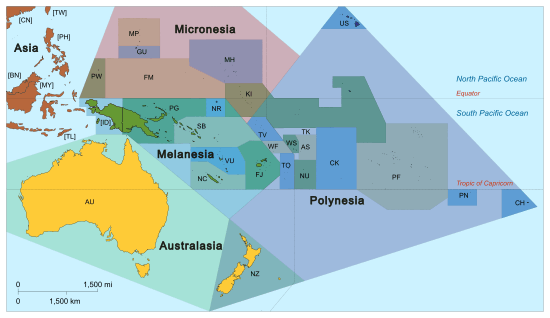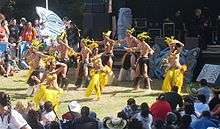Pacific Islander
Pacific Islanders, or Pasifika, are the peoples of the Pacific Islands. It is a geographic and ethnic/racial term to describe the inhabitants and diaspora of any of the three major sub-regions of Oceania (Micronesia, Melanesia, and Polynesia). It is not used to describe non-indigenous inhabitants of the Pacific islands (i.e. citizens of Pacific states who are of Asian and European descent are not ethnically Pacific Islanders).

New Zealand has the largest concentration of Polynesian Pacific Islanders in the world—during the 20th century and into the 21st century the country saw a steady stream of immigration from Polynesian countries such as Samoa, Tonga, the Cook Islands, Niue, and French Polynesia.
Pacific Islander regions
The Pacific islands consist of three main regions:
Polynesia
The islands are scattered across a triangle covering the east-central region of the Pacific Ocean. The triangle is bound by the Hawaiian Islands in the north, New Zealand in the west, and Easter Island in the east. The rest of Polynesia includes the Samoan islands (American Samoa and Western Samoa), the Cook Islands, French Polynesia (Tahiti and The Society Islands, Marquesas Islands, Austral Islands, and the Tuamotu Archipelago), Niue Island, Tokelau and Tuvalu, Tonga, Wallis and Futuna, Rotuma Island, Pitcairn Island, Nukuoro, and Kapingamarangi.
Melanesia
The island of New Guinea, the Bismarck and Louisiade archipelagos, the Admiralty Islands, Bougainville Island, Papua New Guinea, Western New Guinea (part of Indonesia), Aru Islands, the Solomon Islands, the Santa Cruz Islands (part of the Solomon Islands), New Caledonia and Loyalty Islands, Vanuatu (formerly New Hebrides), Fiji, Norfolk Island and various smaller islands.
Micronesia
Kiribati, Nauru, the Marianas (Guam and the Commonwealth of the Northern Mariana Islands), the Republic of the Marshall Islands, Palau, and the Federated States of Micronesia (Yap, Chuuk, Pohnpei, and Kosrae, all in the Caroline Islands).
The sand of Micronesian beaches is sometimes blue instead of the usual tan, particularly in Palau.[1]
Ethnolinguistics
Ethnolinguistically, those Pacific islanders who reside in Oceania are divided into two different ethnic classifications.
- Austronesian language peoples
- Austronesian peoples who speak the Oceanian languages, numbering about 2.3 million, who occupy Polynesia, Micronesia, and most of the smaller islands of Melanesia.
- Papuan language peoples
- Papuan peoples, those who speak the Papuan languages, who number about 7 million, and reside on the island of New Guinea and a few of the smaller islands of Melanesia located off the northeast coast of New Guinea.[2]
Usage by country
The umbrella term Pacific Islands may take on several meanings.[3] Sometimes it refers to only those islands covered by the region of Oceania.[4][5] In some common uses, the term "Pacific Islands" refers to the islands of the Pacific Ocean once colonized by the Portuguese, Spaniards, Dutch, British, French, United States, and Japanese, such as the Pitcairn Islands, Taiwan, and Borneo.[6] In other uses it may refer to islands with Austronesian linguistic heritage like Taiwan, Indonesia, Micronesia, Polynesia, Myanmar islands, which found their genesis in the Neolithic cultures of the island of Taiwan.[7]
Australia
In Australia the term South Sea Islanders was used to describe Australian descendants of people from the more than 80 islands in the western Pacific who had been brought to Australia to work on the sugar fields of Queensland,[8] in the 19th century called Kanakas. The Pacific Island Labourers Act 1901 was enacted to restrict entry of Pacific Islanders to Australia and to authorise their deportation. In the legislation Pacific Islanders were defined as:
"Pacific Island Labourer" includes all natives not of European extraction of any island except the islands of New Zealand situated in the Pacific Ocean beyond the Commonwealth [of Australia] as constituted at the commencement of this Act.[9]
In 2008 a Pacific Seasonal Worker Pilot Scheme was announced as a three-year pilot scheme.[10] The scheme provides visas for workers from Kiribati, Tonga, Vanuatu and Papua New Guinea to work in Australia.[11] The pilot scheme includes one country each from Melanesia (Vanuatu), Polynesia (Tonga) and Micronesia (Kiribati), countries which already send workers to New Zealand under its seasonal labour scheme. Australia's pilot scheme also includes Papua New Guinea.[12][13]
New Zealand

Local usage in New Zealand uses "Pacific islander" (formerly "Pacific Polynesians"[14] or Pasifika) to distinguish those who have emigrated from one of these areas in modern times from the New Zealand Māori, who are also Polynesian but are indigenous to New Zealand.[14]
In the 2013 New Zealand census, 7.4 percent of the New Zealand population identified with one or more Pacific ethnic groups, although 62.3 percent of these were born in New Zealand.[15] Those with a Samoan background make up the largest proportion, followed by Cook Islands Maori, Tongan, and Niuean.[15] Some smaller island populations such as Niue and Tokelau have the majority of their nationals living in New Zealand.[16]
To celebrate the diverse Pacific island cultures, the Auckland region hosts several Pacific island festivals. Two of the major ones are Polyfest, which showcases performances of the secondary school cultural groups in the Auckland region,[17] and Pasifika, a festival that celebrates Pacific island heritage through traditional food, music, dance, and entertainment.[18]
United States
According to the U.S. Bureau of the Census, Population Estimates Program (PEP), a "Native Hawaiian and Other Pacific Islander" is "A person having origins in any of the original peoples of Hawaii, Guam, Samoa, or other Pacific islands. It includes people who indicate their race as 'Native Hawaiian', 'Guamanian or Chamorro', 'Samoan', and 'Other Pacific Islander' or provide other detailed Pacific Islander responses."[19]
According to the Office of Management and Budget, "Native Hawaiian or Other Pacific Islander" refers to a person having origins in any of the original peoples of Hawaii, Guam, Samoa, or other Pacific Islands.
List of Pacific peoples
- Austronesian-speaking peoples
- Polynesians
- Western Polynesian region
- Northeast & South Polynesian region
- Hawaiians
- Māori
- Tahitians
- Tuamotuans
- Tubuai
- Marquesans
- Gambier Islanders
- Cook Islanders
- Rapanui
- Melanesians
- 'Are'are people
- Kanak people
- Kwaio people
- Motuan people
- Ni-Vanuatu
- Fijians
- Micronesians
- Polynesians
See also
References
- Brad Lendon; Isaac Yee (August 4, 2020). "'SOS' in the sand saves Pacific island mariners". CNN. Retrieved August 5, 2020.
- "Pacific Islands on Encyclopædia Britannica".
- William Collins Sons & Co Ltd (1983), Collins Atlas of the World (revised 1995 ed.), London W6 8JB: HarperCollins, ISBN 0-00-448227-1CS1 maint: location (link)
- D'Arcy, Paul (March 2006). The People of the Sea: Environment, Identity, and History in Oceania. University Of Hawai'i Press. ISBN 978-0-8248-3297-1. Archived from the original on 2014-10-30. Retrieved 14 December 2014.
- Rapaport, Moshe (April 2013). The Pacific Islands: Environment and Society, Revised Edition. University of Hawai'i Press. ISBN 978-0-8248-6584-9. JSTOR j.ctt6wqh08.
This is the only contemporary text on the Pacific Islands that covers both environment and sociocultural issues and will thus be indispensable for any serious student of the region. Unlike other reviews, it treats the entirety of Oceania (with the exception of Australia) and is well illustrated with numerous photos and maps, including a regional atlas.
– via JSTOR (subscription required) - Wright, John K. (July 1942). "Pacific Islands". Geographical Review. 32 (3): 481–486. doi:10.2307/210391. JSTOR 210391. – via JSTOR (subscription required)
- Compare: Blundell, David (January 2011). "Taiwan Austronesian Language Heritage Connecting Pacific Island Peoples: Diplomacy and Values" (PDF). International Journal of Asia-Pacific Studies. 7 (1): 75–91. Retrieved 2 May 2015.
Taiwan associations are based on almost forgotten old connections with far-reaching Pacific linguistic origins. The present term Austronesia is based on linguistics and archaeology supporting the origins and existence of the Austronesian Language family spread across the Pacific on modern Taiwan, Indonesia, East Timor, Malaysia,, Singapore, Brunei, Micronesia, Polynesia, the non-Papuan languages of Melanesia, the Cham areas of Vietnam, Cambodia, Hainan, Myanmar islands, and some Indian Ocean islands including Madagascar. Taiwan is in the initiating region.
- "South Sea Islander Project". ABC Radio Regional Production Fund. Australian Broadcasting Corporation. 2004. Retrieved 2008-08-27.
Recognition for Australian South Sea Islanders (ASSI) has been a long time coming. It was not until 1994 that the federal government recognized them as a distinct ethnic group with their own history and culture and not until September 2000 that the Queensland government made a formal statement of recognition.
- "Pacific Island Labourers Act 1901 (Cth)" (PDF). Documenting a Democracy. National Archives of Australia. 1901. Retrieved 2008-08-27.
- Australian Institute of Criminology: Australia's Pacific Seasonal Worker Pilot Scheme: Managing vulnerabilities to exploitation
- "Pacific guestworker scheme to start this year". Australian Broadcasting Corporation. 2008-08-17.
- "Seasonal Worker Pilot Scheme is more proof of Australia's new Pacific focus" (Press release). The Hon Duncan Kerr SC MP; Parliamentary Secretary for Pacific Island Affairs. 2008-08-20.
- Australian classification standards code Pacific islanders, Oceanians, South Sea islanders, and Australasians all with code 1000, i.e., identically. This coding can be broken down into the finer classification of 1,100 Australian Peoples; 1,200 New Zealand peoples; 1,300 Melanesian and Papuan; 1,400 Micronesian; 1,500 Polynesian. There is no specific coding therefore for "Pacific islander"."Australian Standard Classification of Cultural and Ethnic Groups (ASCCEG) - 2nd edition" (pdf - 136 pages). Australian Bureau of Statistics. 2005-07-07. Retrieved 2008-08-27.
- Crocombe, R. G. (1992). Pacific Neighbours: New Zealand's Relations with Other Pacific Islands : Aotearoa Me Nga Moutere O Te Moana Nui a Kiwa. University of the South Pacific. p. xxi. ISBN 978-982-02-0078-4.
- "Pacific peoples ethnic group", 2013 Census. Statistics New Zealand. Accessed on 18 August 2017.
- Smelt, and Lin, 1998
- "Polyfest NCEA credits / Pasifika Education Plan / Home - Pasifika". Te Kete Ipurangi (TKI). Retrieved 18 August 2017.
- "Thousands turn out for Pasifika Festival". Radio New Zealand. 25 March 2017. Retrieved 18 August 2017.
- "Information on Race". United States Census Bureau. Archived from the original on April 3, 2013. Retrieved March 27, 2013.
Further reading
- Lal, B., & Fortune, K. (Eds.). (2000). The Pacific Islands: An encyclopedia. Honolulu, HI: University of Hawaii Press.
- Okihiro, Gary Y. American History Unbound: Asians and Pacific Islanders (University of California Press, 2015). xiv, 499 pp.
- Smelt, R., & Lin, Y. (1998). Cultures of the world: New Zealand. Tarrytown, NY: Marshall Cavendish Benchmark
- Thomas, Nicholas, Islanders: The Pacific in the Age of Empire, Yale University Press, 2010. ISBN 978-0-300-12438-5
External links
- Statistics New Zealand . Retrieved March 21, 2013.
- Asian Pacific Americans in the U.S. Army
- Native Hawaiian Pacific Islander Association